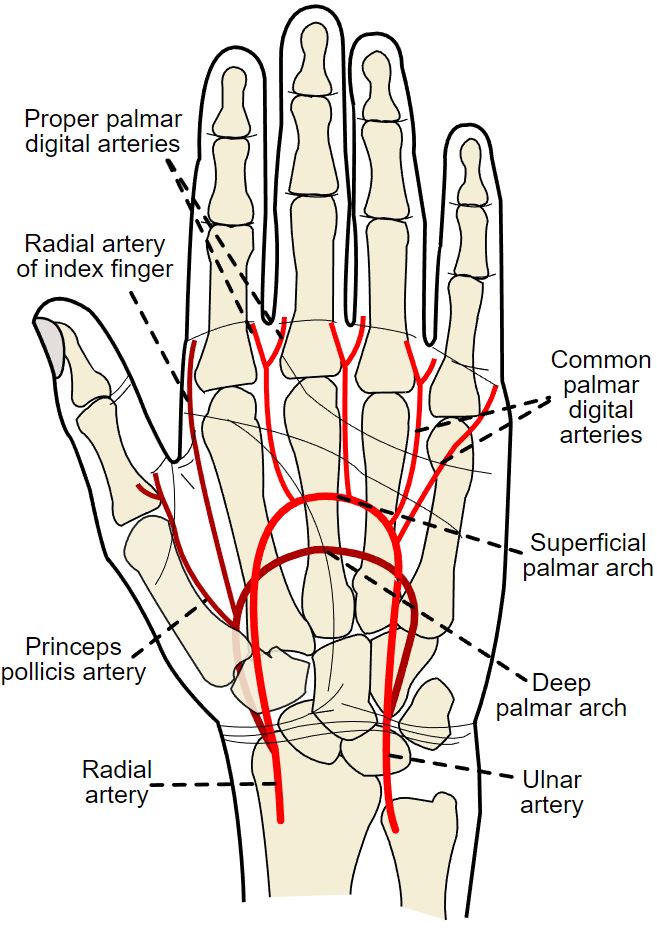[1]
Dawson-Amoah K, Varacallo M. Anatomy, Shoulder and Upper Limb, Hand Intrinsic Muscles. StatPearls. 2023 Jan:():
[PubMed PMID: 30969632]
[2]
Okwumabua E, Sinkler MA, Bordoni B. Anatomy, Shoulder and Upper Limb, Hand Muscles. StatPearls. 2023 Jan:():
[PubMed PMID: 30725914]
[4]
Brzezinski M, Luisetti T, London MJ. Radial artery cannulation: a comprehensive review of recent anatomic and physiologic investigations. Anesthesia and analgesia. 2009 Dec:109(6):1763-81. doi: 10.1213/ANE.0b013e3181bbd416. Epub
[PubMed PMID: 19923502]
[6]
Singh S, Lazarus L, De Gama BZ, Satyapal KS. An anatomical investigation of the superficial and deep palmar arches. Folia morphologica. 2017:76(2):219-225. doi: 10.5603/FM.a2016.0050. Epub 2016 Sep 26
[PubMed PMID: 27665957]
[8]
Gnanasekaran D, Veeramani R. Newer insights in the anatomy of superficial palmar arch. Surgical and radiologic anatomy : SRA. 2019 Jul:41(7):791-799. doi: 10.1007/s00276-019-02223-w. Epub 2019 Mar 28
[PubMed PMID: 30923841]
[9]
Hallett S, Jozsa F, Ashurst JV. Anatomy, Shoulder and Upper Limb, Hand Anatomical Snuff Box. StatPearls. 2023 Jan:():
[PubMed PMID: 29489241]
[11]
Valenzuela M, Varacallo M. Anatomy, Shoulder and Upper Limb, Hand Interossei Muscles. StatPearls. 2023 Jan:():
[PubMed PMID: 30521193]
[12]
Rodríguez-Niedenführ M, Burton GJ, Deu J, Sañudo JR. Development of the arterial pattern in the upper limb of staged human embryos: normal development and anatomic variations. Journal of anatomy. 2001 Oct:199(Pt 4):407-17
[PubMed PMID: 11693301]
[13]
Valenzuela M, Bordoni B. Anatomy, Shoulder and Upper Limb, Hand Palmar Interosseous Muscle. StatPearls. 2023 Jan:():
[PubMed PMID: 30725850]
[14]
Coveliers HM, Hoexum F, Nederhoed JH, Wisselink W, Rauwerda JA. Thoracic sympathectomy for digital ischemia: a summary of evidence. Journal of vascular surgery. 2011 Jul:54(1):273-7. doi: 10.1016/j.jvs.2011.01.069. Epub 2011 Jun 8
[PubMed PMID: 21652164]
[16]
Zarzecki MP, Popieluszko P, Zayachkowski A, Pękala PA, Henry BM, Tomaszewski KA. The surgical anatomy of the superficial and deep palmar arches: A Meta-analysis. Journal of plastic, reconstructive & aesthetic surgery : JPRAS. 2018 Nov:71(11):1577-1592. doi: 10.1016/j.bjps.2018.08.014. Epub 2018 Aug 24
[PubMed PMID: 30245020]
Level 1 (high-level) evidence
[17]
Habib J, Baetz L, Satiani B. Assessment of collateral circulation to the hand prior to radial artery harvest. Vascular medicine (London, England). 2012 Oct:17(5):352-61. doi: 10.1177/1358863X12451514. Epub 2012 Jul 19
[PubMed PMID: 22814998]
[19]
Korambayil PM. Use of superficial palmar arch for bridging the gap in digital revascularisation. Indian journal of plastic surgery : official publication of the Association of Plastic Surgeons of India. 2011 Sep:44(3):511-6. doi: 10.4103/0970-0358.90844. Epub
[PubMed PMID: 22279293]

